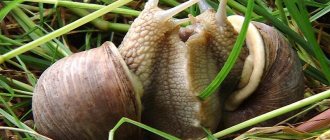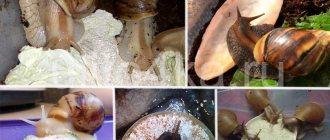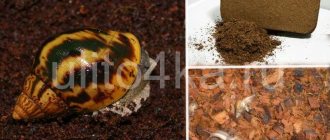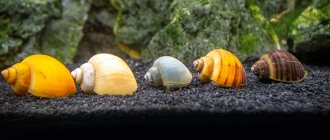If you make a rating of the popularity of pets, then Achatina snails will take far from the last place.
Previously, aquariums were used to keep fish and other aquatic inhabitants, but now fans of the exotic have proven that giant mollusks can live in these containers and filling with water is not at all necessary.
Achatina attracts with its gigantic size , which is tens of times larger than ordinary snails.
They are very unpretentious, do not require special care, and are able to live for a long time without the supervision of the owner, if he suddenly has urgent matters and needs to leave for a few days.
Peculiarities
For all Achatina snails, reproduction in their natural habitat occurs without any problems, but at home there are certain difficulties , which include the following:
- After the female has finished laying eggs, her growth may stop or slow down greatly;
- Problems with the snail shell may occur due to a lack of calcium in the body. Lamination and the appearance of cracks will reduce its attractiveness;
- The fertility of snails can later create problems regarding the maintenance of voracious offspring and their accommodation.
Benefits and harms
It is difficult to compare a snail as a pet with a kitten, puppy or guinea pig, but such pets have a number of undeniable advantages over any other animals:
- Does not require daily walks.
- You only need to feed once a day.
- They do not make sounds (except when eating).
- Interesting to watch.
- It can be trained by developing conditioned reflexes in mollusks.
- They can remain unattended for a long time, hibernating.
- High life expectancy up to 10 years (with proper care).
In addition to such advantages, the snail can also be useful to its owner for cosmetic and medical purposes. In order to protect their body from friction while moving, Achatina snails produce special mucus, which:
- promotes healing of the sole of the body in case of damage;
- participates in the process of repairing damage to the shell.
The properties of snail mucus are used by humans in:
- economic activity;
- folk and alternative medicine;
- cosmetology.
After lengthy scientific research, the composition of snail mucus has been carefully studied. It includes the following components:
As a result of research, it has been established that the mucus produced by snails contains the following components:
- Vitamins of groups A, S.E.
- Collagen.
- Amino acids.
- Elastin.
- Antibacterial ingredients.
- Allatonin.
The properties of snail mucus include:
- assistance in the treatment of bronchitis and other diseases of the upper respiratory tract;
- the formation of a protective cover (film) on human skin that allows oxygen to pass through and prevents moisture loss;
- hypoallergenic;
- accelerating the process of cellular regeneration;
- analgesic effect.
In cosmetology, snail mucin Achatina is used for:
- combating wrinkles around the eyes and other age-related skin changes;
- eliminating facial wrinkles;
- skin rejuvenation;
- cleansing of dead cells (peeling);
- restoring the water balance of the skin;
- skin regeneration, including after aggressive cosmetic procedures;
- lightening the skin and getting rid of pigmentation;
- treatment of scars and scars.
Achatina snails and their mucus are often used in alternative medicine for:
- treatment of postoperative scars;
- speedy healing of wounds and burns;
- eliminating cellulite and cleansing the body of accumulated heavy fats, which cannot be eliminated by traditional methods and physical exercises;
- relieving muscle spasms and tension without additional pain;
- therapy of inflammatory processes that provoke various diseases and even infertility;
- treatment of stress and diseases associated with intense mental and physical stress;
- therapy of vegetative-vascular dystonia;
- restoration of the nervous system;
- treatment of varicose veins.
Achatina snails are absolutely safe for humans, but in some cases they can cause harm:
- Mucus may contain dangerous bacteria and pathogenic microorganisms, which, if they get into open wounds, can lead to dangerous diseases.
- Despite the hypoallergenic nature of snail mucus, in some cases its use causes undesirable reactions on the skin, including angioedema.
- Eating shellfish meat can also cause allergies.
Considering that Achatina are purchased mainly from breeders and bred in captivity, they are not carriers of dangerous tropical diseases.
How to prepare?
In order for the offspring that you plan to get from Achatina snails to be healthy and viable, you should create comfortable living conditions. First of all, you need to monitor the temperature in the terrarium.
It should not be below 28 degrees Celsius. Temperature fluctuations should not be allowed .
It is advisable to make the litter at least ten centimeters thick. It is best if it is a moistened coconut substrate. The terrarium needs to be cleaned regularly and calcium supplements for snails must be provided.
You can use crushed shell rock, sepia, chalk and mineral stones as these. They must remain in the terrarium all the time, right up to the hatching of the mollusks. This way the snail will quickly recover after pregnancy.
Making fertilizer
If the snail has laid eggs, you can use them as additives for other shellfish. To do this you need to take the following steps:
- Achatina eggs are washed from soil residues, placed in a plastic bag or plastic container, and sent to the freezer.
- After 2 - 3 days they are placed on a radiator to dry. After 1 - 3 days (large eggs dry more slowly), they should begin to crumble. This will indicate the completion of the drying process.
- Some snail breeders dry the masonry without freezing. Dried eggs should be ground and given to snails in any quantity as independent feeding. Or as part of a calcined mixture.
- To prevent Achatina snail eggs from deteriorating during the drying process, they should be provided with normal ventilation.
But if they begin to darken, become moldy and smell unpleasant, it is absolutely forbidden to give such feeding to snails.
What if there are a lot of eggs in the clutch?
The fertility of Achatina varies and one female is capable of laying an incredibly large number of eggs. If we take into account the percentage of hatching, the owner of the mollusks may face the problem of where to put such offspring . Those who have been working with giant snails for a long time recommend thinning out the clutches.
It is impossible to determine whether eggs are fertilized or not, so those that turn out to be extra need to be frozen or boiled. This is done to prevent the possibility of uncontrolled reproduction, as discarded eggs may hatch.
How long does it take for the eggs to hatch?
After mating of the female and male snails has occurred, Achatina begins a period of pregnancy, ending with the laying of eggs . Today, all types of giant snails are oviparous with different gestation periods.
Basically, the snail lays eggs directly into the substrate. In some cases, the female may dig a shallow hole and then cover it with soil. In total, Achatina is capable of laying a large number of eggs at a time, reaching several hundred.
The average time from the start of mating to the hatching of eggs is about 45 days .
Reproduction of Achatina
Reproduction of Achatina snails is possible only with the onset of puberty. An individual is considered an adult from the moment it reaches the age of 6 months; Achatina is ready for mating after the appearance of a small tubercle on the neck, which is the reproductive organ of snails.
Immediately after the mating process, the time of pregnancy officially begins; during this period, the gastropod lays eggs. Pregnancy is different for every female. On average, Achatina snail eggs hatch in 1–2 months. It is possible to see the hatching eggs of Achatina if you look into the spiracle of Achatina.
There are recorded cases when a snail's pregnancy ends in childbirth, as a result of which Achatina gives birth to viable small mollusks.
The mollusk buries its future offspring in the ground; often for these purposes, Achatina prepares a hole in advance where they lay their eggs. Achatina snails are capable of breeding all year round, in separate places in small groups or together.
Pregnancy has a negative impact on the female; she should be fed well, adding various supplements.
Egg care
Caring for egg-laying giant snails is very easy.
There are several rules, the observance of which contributes to the safety of eggs and the breeding of offspring:
- The eggs must remain in the substrate at all times;
- The temperature in the terrarium should not be below 28 degrees Celsius;
- should always ;
- The soil should not be allowed to dry out, nor should it be over-moistened;
- There should be no water or any other liquid under the egg laying itself, otherwise the eggs may rot.
It is not recommended to touch laid eggs with your hands. Ideally, when everything will remain as it was. You can show your intervention in the case when the eggs are laid by the female along the entire perimeter of the terrarium. This can be corrected by collecting them carefully and putting them in one place, lightly sprinkling them with substrate on top.
Mollusks appear on days 21-28 . It happens that some eggs remain unfertilized. Therefore, you should not plan in advance how many small snails will hatch. On average, about 80% of babies are produced from a clutch.
Keeping small snails
Snails hatched from eggs are in no hurry to leave the nest and remain for some period in the substrate. They begin to emerge after a few days in small groups.
The shell that remains after hatching is almost completely eaten by the kids , which facilitates the process of cleaning the terrarium.
How deep the masonry was and how dense the substrate is depends on how soon it will be possible to observe the life activity of young Achatina.
Small snails do not require any separate feeding or care. The same applies to them as for adults. The main thing is to provide them with constant access to food so that development and growth are active.
Behavior of Achatina Reticulata
The reticulata snail is a very active animal; it remains active not only at night, but also during the day. She is like a child, she is interested in everything. The snail stretches its head with enviable curiosity and tries not to miss anything. Achatina is unpretentious in care and nutrition. Scientists have discovered short-term memory in the reticulum. The snail easily gets accustomed to eating according to the time and place where its feeder with food is located. The snail also recognizes its owner by smell and happily makes contact with him. Achatina reticulata is a social animal; they often sleep together on snags or in a feeding trough. Retics love to communicate and study surrounding objects in the palm of the owner; by the way, there is no allergy to snail mucus. They are widely used for anti-aging procedures in beauty salons and at home.
Achatina reticulata is used for cosmetic procedures. Retic mucus promotes the healing of wounds and burns, smoothes rough scars and deep wrinkles. And there are legends about the medicinal properties of snail meat.
Many snail lovers keep Achatina reticulata as an ideal pet. And you?
Care
As soon as the babies are born, they can be in the same terrarium with adults. They need to be planted only if there is very little space for all the mollusks. The snails then cannot receive adequate nutrition, which affects their growth and development. If the decision to rehome the babies is made, then you should act very carefully, since their shells are fragile and delicate .
Experts recommend dividing Achatina before they become sexually mature. Otherwise, if you miss the moment, uncontrolled mating may result. It is believed that several months after mating has occurred, the female is able to lay eggs, even if there was only one contact .
Keeping and propagating Achatina at home is a very exciting activity that does not require any additional costs and is not accompanied by difficulties. Plus, you can make a profit if you start selling small snails, since they are popular and many people want to buy such a pet for themselves.
Useful tips
The snail can be considered a rather specific pet, however, it also has its fans. Owners note their ease of care and ability to reproduce quickly. As for Europe and Russia, the mollusk cannot be found here in the natural environment. Most often it is planted for decorative purposes. If you want to decorate your aquarium, it’s not difficult to do. The main thing is to think about the safety of the shellfish. You can use natural elements, for example, moss or beautiful driftwood. However, we must not forget about disinfection.
As for care, it is advisable for adults to provide a bowl of clean water. In order for the humidity to remain at the required level, the lid must always be tightly closed. Firstly, care is not burdensome for the owner. Secondly, she does not require walks. It is also impossible not to note the minimal maintenance costs.
Achatina is a very quiet pet, it is especially active in the dark, however, provided there is sufficient humidity, it can also appear during the daytime. If the temperature drops below +9 degrees, the mollusk goes into hibernation.
When creating a microclimate, we must not forget that Achatina is a tropical mollusk. To ensure comfort, it needs warmth and moisture. It is best if the air temperature remains at 25-28 degrees. If the room is cooler, the snail will become less active. Don't forget to regularly spray your pet's home with water. The best houses for clams are containers made of glass or plastic. Ventilation must be provided to ensure sufficient access to fresh air. It is also necessary to ensure that the top lid of the container is heavy and does not move, otherwise there is a risk that Achatina will run away.
How much water Achatina has enough can be understood by its behavior. Hidden in the shell, the mollusk signals dryness in the aquarium, and sitting on the walls for a long time, on the contrary, signals excessive humidity. If the owner needs to leave for some time, the snail can be provoked into hibernation. This creates dryness in the container. To wake up a clam, it should be placed under a stream of warm water. You should focus on the size of the snail; specimens that are too small can squeeze into the holes, because they move well along the walls and lid. Experts also recommend avoiding bark and sawdust. Your pet's delicate body can be easily scratched.
Snails feed on plant foods. Soft plants are great. At a young age, Achatina will prefer living plants; when they are more mature, rotting remains will do. Most often, at home, shellfish are fed with cabbage, cucumbers, zucchini and other not too hard vegetables.
A pet will not be able to actively grow and develop without protein and calcium. Therefore, it would be a good idea to occasionally pamper him with pieces of boiled chicken. Porridge made from a cereal mixture will also work. Pickles and smoked products are prohibited. At a tender age, you should not give snails a lot of food, as they will tend to burrow into it, which can lead to suffocation.
Achatina is a land mollusk. Its length can reach 30 centimeters, which is an impressive value. Natural habitat is the tropics. As for France, Achatina is very popular there. They reproduce and grow very quickly. This allows the active use of such snails in local cuisine. As for living in the natural environment, the snail is quite harmful to agricultural crops. Sugar cane is considered her favorite delicacy. In addition, Achatina suffers from a lack of calcium, so it scrapes lime off the walls of buildings with its shell. This causes them significant harm.
What soil to choose for Achatina snails, see below.
Aquarist with many years of experience
The Achatin snail is the largest land mollusk. Since the original habitat of snails is the tropics, special conditions are required for their maintenance. The life of mollusks, not to mention the ability to reproduce, can depend on a properly selected terrarium and soil.
Therefore, before buying a new pet, it is important to study the characteristics of the habitat and the rules for selecting soil for Achatina snails
Special conditions are required for keeping Achatina snails











